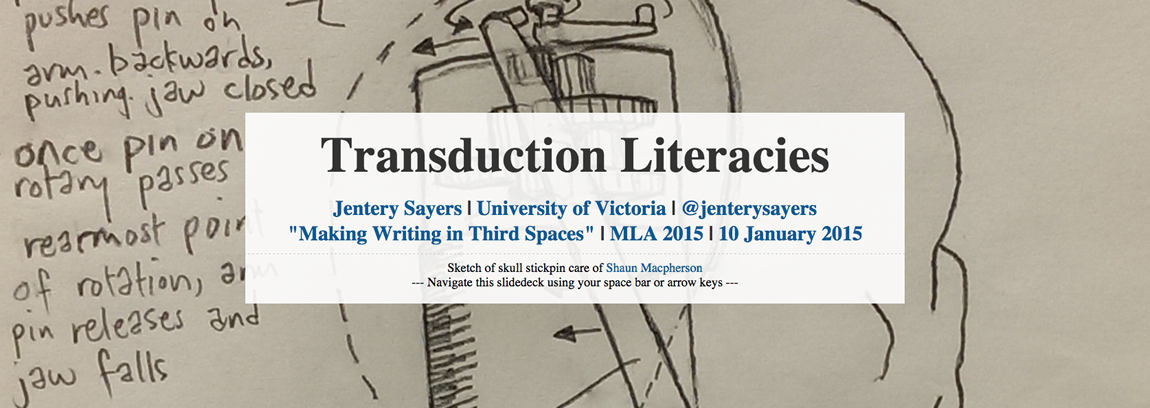On Saturday, I had the wonderful opportunity to present on the “Making Writing in Third Spaces” panel during the 2015 Modern Language Association convention in Vancouver. Thank you to the Division on the Teaching of Writing, including bonnie lenore kyburz, for inviting me. Additional thanks to Laurie Gries and Byron Hawk, whose talks about data visualization and sound recording, respectively, were incredibly compelling.
Here are the slides and source files for my “Making Writing” talk, titled “Transduction Literacies.” During the talk, I discussed humanities labs as third spaces for writing, where writing is not reduced to merely communicating the results of research. Instead, it serves as a foundation for how lab culture is constructed and performed. Next I defined transduction literacy as knowledge of how this material becomes that material, drawing upon research by Matthew Fuller, Wendy Chun, Virginia Kuhn, Victor Vitanza, Annette Vee, and David Rieder. I also expressed concerns about some impulses in popular “make” cultures and how those impulses are manifesting in certain creative + critical practices. Among these concerns are tendencies to wonder at computational objects as withdrawn or inaccessible entities and to treat glitches as exceptions instead of systemic features. Here, I pointed to work by Lisa Nakamura, Alexander Galloway, Garnet Hertz, and Bethany Nowviskie for persuasive responses and alternatives. And I stressed how, in the Maker Lab and elsewhere, we can understand transduction literacy as a way to avoid fetishizing technologies and glitches through a blend of analog and digital culture, print and electronic materials, bodies and data, legibility and opaqueness, individuation and networks, remembering and forgetting. To show how such a blend is achieved through academic writing, I directed the audience to Nina Belojevic’s “Circuit Bending Videogame Consoles as a Form of Applied Media Studies” (NANO, issue 5), which I also analyzed as an instance of transduction literacy.
Using Belojevic’s work as evidence, I concluded with a gesture, echoing Jody Shipka and Cynthia Selfe, to further expand our understanding of academic writing. More specifically, I suggested that (at least in the paradigm of transduction literacy) technical writing is not just documentation, critical writing is not just reflection, and creative writing is not just individual expression. Instead, among other things, technical writing is historical inquiry, critical writing is actionable practice, and creative writing is platform design. Among the implications of these shifts are writing that occurs between bits and atoms, a possible turn from process reflection to executable culture in the composition classroom, an additional turn from read-and-repeat models of learning to evocation through programming and design, and—finally—the need to draw the attention of more digital humanities practitioners to writing studies research (beyond but also including research on pedagogy). Rather than treating technologies as vehicles for knowledge deficits, I also suggested telling students: “What you already know is enough.” Informed by Liz Henry’s work in feminist hackerspaces such as Double Union, this statement is not meant to discourage learning. It is meant to prompt instructors to build on student experiences (e.g., with zines, graphic design, games, music, and craft) that may not initially appear relevant to research or may not be validated by common models of academic expertise. Perhaps most important, “what you already know is enough” is meant to refrain from putting all the weight of arts and humanities research on technologies, programming, and platforms, which can too easily be perceived as solutions in a so-called “digital age.”
The “Transduction Literacies” slidedeck has additional links to related material, if you’re interested in the references and contexts. As our research continues, I hope to further unpack this form of literacy, which we tend to practice tacitly in the lab but have not fully articulated in writing. In the meantime, thank you for your patience with the point form. More, as always, soon.
Post by Jentery Sayers, attached to the Makerspace project, with the news tag. Featured image for this post care of Shaun Macpherson and Jentery Sayers.

